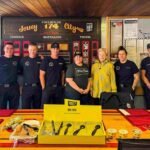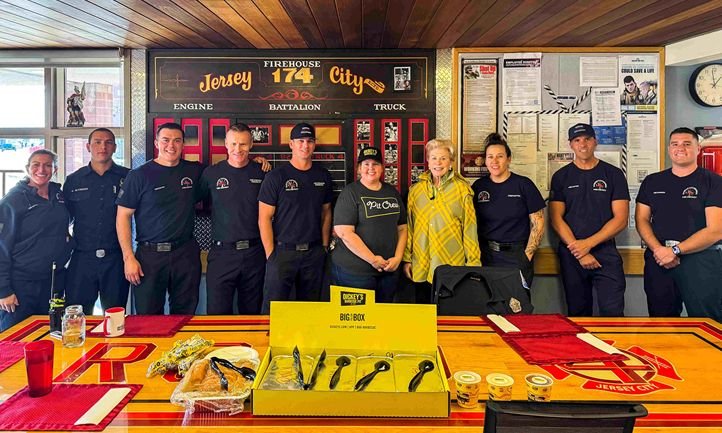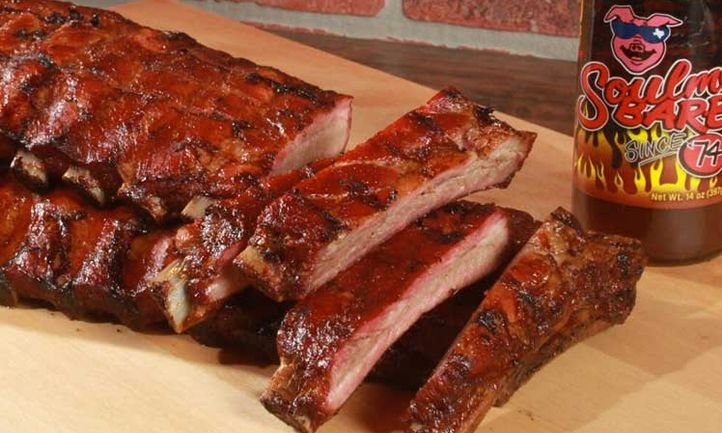Two cars this year perhaps best captured the magic of Retromobile. Both were extremely rare, and both were for sale. One was priced at $23 million; the other you could take away for just $12,000. The $23 million car was a McLaren F1, one of two built in white and, with just 1,000 miles on the clock, believed to the second-lowest-mileage F1 in the world (shown at bottom). The $12,000 car was a 1988 Citroën AX10 (below), a tiny front-drive hatchback with an engine one-sixth the size of the McLaren’s producing just 7 percent the power. More than 2.5 million AXs were built between 1986 and 1998. But what made this one unique was that it had covered just 30 miles. This 37-year-old Citroën looked like it had rolled off the production line yesterday.
Retromobile started out as a niche event where collectors could buy and sell classic cars and car parts, both high- and low-end. Bruce Meyer, founding chairman of the Petersen Automotive Museum in Los Angeles and a longtime collector with impeccable taste in classic racing cars and vintage hot rods, has been coming to Retromobile for more than 30 years. “I used to come over to Paris on business, and I could break away for half a day and cover it,” Meyer said. “Now I make a dedicated trip each year.” That’s because Retromobile has grown; these days, it sprawls across three pavilions at the Parc des Expositions in Paris, once home to the Paris Auto Show.
You’ll see hundreds and hundreds of classic cars—and motorcycles, too—at Retromobile. And most of them are for sale, along with thousands of parts and components, among the coolest of which at this year’s show was a complete, never-run Chrysler-Lamborghini 3.5-liter Formula 1 engine designed by Mauro Forghieri. Dubbed the LE3512, this naturally aspirated, 80-degree V-12 would rev to 13,800 rpm and made up to 710 hp. Though singularly unsuccessful on the track, it would make a helluva project car engine—perhaps for a SEMA-busting mid-engine Chrysler Minivan custom, a Mopar answer to the F1-engined Ford Transit Supervan. Price? $100,000, which includes a bunch of brand-new spares. In addition to oily bits, Retromobile also has an abundance of clothing, art, accessories, models, memorabilia, and even vintage watches for sale.
There were plenty of cars wearing six-, seven-, and even eight-figure price tags on display this year, among them rarities like the 1969 Lamborghini Miura P400 S that was one of just three Miuras ever painted Verde Scuro, a fabulous dark green. Others included an impeccably restored 1952 split-windshield Porsche 356 Pre-A 1300, and a gorgeous French Racing Blue 1960 Ferrari 250 SWB, one of 46 aluminum-bodied cars built that year, that was raced to second place in the Tour de France by owner Pierre Dumay and French F1 driver Jo Schlesser.
But there was also a hall packed with cars for sale that all cost no more than about $30,000. Among the highlights: an Oldsmobile Toronado (above), our 1966 Car of the Year (COTY) winner, with just 30,000 miles on the clock; a nicely restored Studebaker Avanti; a stylish and rare (just over 8,000 built between 1969 and 1983) Peugeot 504 Cabriolet; and an early Austin Mini pickup, a body style that accounted for just over 1 percent of all Minis ever made.
Retromobile’s slogan this year, “le passé a toujours un future” (the past always has a future), seemed especially apt. Faced with increasing competition from a wave of Chinese manufacturers building cars of rapidly improving quality and capability, established automakers are looking to leverage their histories, and this year’s show included official displays from Renault, Citroën, Mercedes-Benz, Porsche, Bentley, Skoda, and even Mazda, Toyota, and Cadillac. “The Chinese can build great cars,” one European auto executive said, noting that a prototype of Xiaomi’s SU7 Ultra, a 1,527-hp, 217-mph electric sedan from a company that started building cars just four years ago, had last October beaten the Nürburgring lap record set by Porsche’s Taycan. “But,” he said, indicating the mouth-watering classics on his company’s stand, “they don’t have this heritage.”
Does heritage mean anything, though? This year marks the 70th anniversary of the launch of the Citroën DS, in the context of its contemporaries still the most audacious and advanced production car ever launched. And for Retromobile, DS Automobiles, the Citroën spin-off luxury brand launched in 2009, recreated the iconic DS Balloon—a DS with filled-in wheel wells and a covered underbody resting on four giant orange spheres—unveiled by Citroën advertising director Claude Puech in 1959 to highlight the car’s unique hydropneumatic suspension system. The display also included a selection of DS models from 1956 through 1972. The problem is they made the new DS Automobiles flagship EV, the No.8, look as unimaginative as its name.
Renault did a far better job of linking the old with the new. Its stand consisted of a Renault R4, a low-cost car launched in 1961 to combat Citroën’s 2CV, an R5 hatchback, and a sporty R17, a two-door coupe that was sold in small numbers in the U.S. until 1979, plus the modified 40CV that in 1926 averaged 107.9 mph over 24 hours. They were lined up opposite modern electric-powered avatars that cleverly captured their visual spirit. The modern version of the old record car, dubbed the Filante, is a concept that previews lightweight carbon-fiber construction, brake- and steer-by-wire systems, and new low-rolling-resistance Michelin tires. The 17 EV is a factory restomod with a 270-hp powertrain done in collaboration with French product designer Ora Ito. But the modern 4 EV will soon join the Renault 5 E-Tech, a car we found irresistibly fun to drive, in Renault’s European showrooms.
Mazda’s stand celebrated the 35th anniversary of the world’s most successful sports car, the MX-5 Miata, with a selection that not only included the new 35th Anniversary Edition, but also rarities such as the pretty NB-based Coupé, 179 of which were built, and the NC Superlight concept first seen in 2009. Bentley’s stand featured the third of the vintage Speed Six continuation cars so far completed, plus a current Continental GT Convertible painted a matching shade of pale blue. Cadillac, predictably, showed one of its rocket-age classics, a 1958 Eldorado convertible. It overwhelmed the Lyriq SUV now being imported into Europe in limited numbers and parked alongside it. Toyota showed a 1965 Sports 800, noting that in 1977 it had built a version with a hybrid powertrain that included a gas turbine as well as an internal combustion engine.
For Mercedes-Benz Heritage boss Marcus Breitschwerdt, Retromobile is a big business opportunity. “This is the most important show in the world,” he said. “All the collectors are here, and all the restorers are here. And what’s good is that when the restorers want to do a Mercedes-Benz, they have to come to us to get the original parts.” Among the exhibits on the Mercedes-Benz stand were a naked 300SL Gullwing body shell, part of a restoration project currently underway at the Mercedes-Benz Heritage Classic Center in Fellbach, Germany, and a C111-II from the company’s own collection, alongside which was an original four-rotor Wankel rotary engine. Also on the stand was a 1971 short-wheelbase 600 sedan once owned by legendary opera singer Maria Callas and an immaculate 1988 R107 300 SL roadster with fewer than 2,300 miles on the clock, finished in rare Surf Blue and with a manual transmission. Both these cars were for sale.
It’s not just the big automakers that are coming to Retromobile to sell cars. Kimera Automobili builds exquisite restomods that pay tribute to one of the most iconic rally cars of all time, Lancia’s 037. Like the original 037 rally cars, the Kimera is based on the mid-engine Lancia Montecarlo coupe, a car built between 1975 and 1981 and a version of which was sold in the U.S. as the Lancia Scorpion. The Montecarlo’s steel monocoque is retained but is heavily reinforced with new tubular structures front and rear that locate a forged multilink suspension, and it’s cloaked in carbon-fiber panels. The 2.1-liter, transverse-mounted engine has been re-engineered and is both supercharged and turbocharged, like in the fearsome Group B Lancia Delta S4. The rear-drive Kimera Evo37 has 550 hp; the all-wheel-drive Kimera Evo38 has 600 hp. They are hand-built in tiny numbers, and founder and CEO Luca Betti says several cars have been sold to U.S. customers.
Retromobile is unique, with a vibe that combines the best of Monterey Car Week with SEMA and the Hershey Swap Meet. You can get up close and personal with cars you’ve likely never seen before, everything from a 1920s Citroën Kegresse half-track to an Aston Martin Valkyrie; from a road-legal 1965 Ford GT40 specced by Carroll Shelby himself to the AGTZ, a Zagato-bodied version of the delightful Alpine A110; from a WWII-era Volkswagen 166 Schwimmwagen, an amphibious version of the German Army’s ubiquitous Kübelwagen, to the Ferrari 712P, a Can-Am racer driven by Mario Andretti powered by the largest Ferrari engine ever, a 7.0-ilter V-12 that made 710 hp. And you can also kick the tires on interesting classics we mere mortals can afford before heading off for a great meal in a nearby Parisian brasserie. It’s the coolest car show on the planet.











